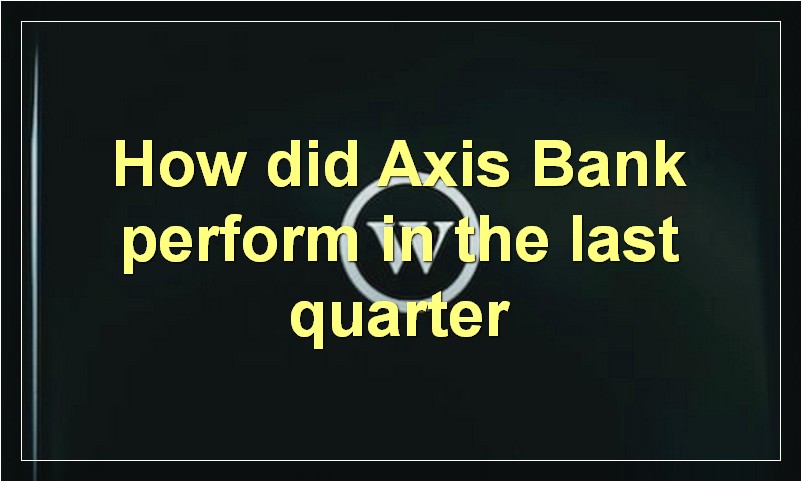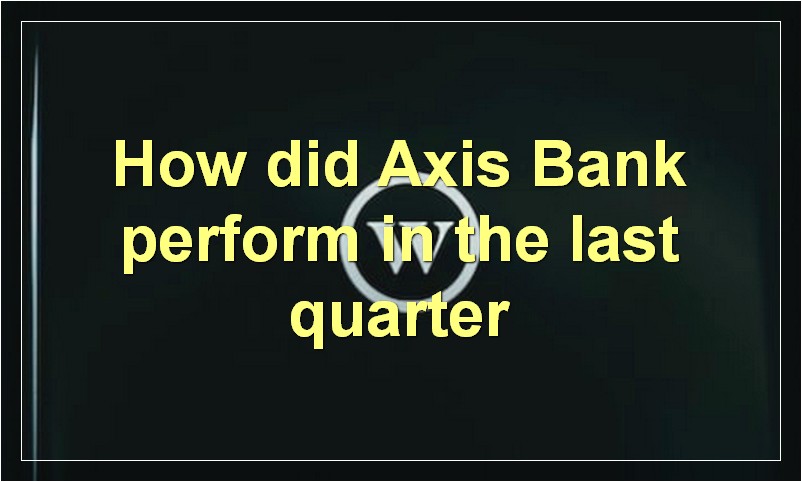Axis Bank, India’s third largest private sector bank, has a long and storied history dating back to its founding in 1993. Today, the bank is a major player in India’s banking sector, with a strong presence in both retail and corporate banking. Axis Bank is well positioned to continue its growth in the years to come, thanks to its strong focus on technology and innovation.
What is the history of Axis Bank
Axis Bank is one of the leading banks in India with a strong presence in retail, SME and corporate banking. The bank has a rich history dating back to its inception in 1993. Axis Bank was originally known as UTI Bank and was set up to provide banking services to the customers of Unit Trust of India (UTI). In 2004, the bank was renamed as Axis Bank following the merger of UTI Bank with its parent company, UTI Financial Services Ltd.
Axis Bank has grown rapidly over the years and today it has a nationwide network of over 4,000 branches and 12,000 ATMs. The bank offers a wide range of products and services to its customers including savings and deposit accounts, personal and business loans, credit cards, forex services and more. Axis Bank is also one of the few banks in India to offer Islamic banking products and services.
The bank has always been at the forefront of innovation and has introduced several first-of-its-kind products and services in the Indian banking industry. Some of these include the country’s first contactless credit card, mobile banking app for small businesses and an online marketplace for SMEs. With a strong focus on technology, Axis Bank is well positioned to meet the evolving needs of its customers and continue its growth trajectory in the years to come.
How did Axis Bank perform in the last quarter

Axis Bank’s net profit for the quarter ended December 31, 2020, rose to Rs 1,682 crore from Rs 1,604 crore in the previous quarter. The bank’s total income grew to Rs 21,916 crore in the quarter under review from Rs 20,764 crore in the corresponding period of the previous fiscal.
The improvement in financials was driven by an expansion in the net interest margin (NIM) and a reduction in provisioning for non-performing assets (NPAs).
The NIM – the difference between the interest earned on loans and advances and the interest paid on deposits – expanded to 3.65 per cent in the quarter under review from 3.57 per cent in the previous quarter.
Provisions for NPAs declined to Rs 2,455 crore in the December quarter from Rs 3,294 crore in the September quarter.
The gross NPA ratio improved to 7.61 per cent at the end of December 2020 from 8.71 per cent at the end of September 2020. The net NPA ratio also declined to 2.36 per cent from 2.82 per cent during the same period.
What are analysts saying about Axis Bank’s future prospects
Axis Bank is one of the leading banks in India and its future prospects look very promising. Analysts are bullish on the stock and believe that it has a lot of potential to grow in the coming years. The bank has a strong balance sheet and is well-positioned to take advantage of the growing economy in India. The stock is currently trading at a discount to its peers and is a good long-term investment.
What is Axis Bank’s dividend yield
Axis Bank’s dividend yield is the percentage of a company’s current share price that it pays out as dividends. For example, if a company has a share price of $100 and it pays out $5 in dividends per year, then its dividend yield would be 5%.
What is the price-to-earnings ratio for Axis Bank
The price-to-earnings ratio (P/E ratio) for Axis Bank is 24. This means that for every ₹1 of earnings, the company’s stock trades at ₹24.
The P/E ratio is a good way to compare different companies in the same industry. It’s also a good way to compare different industries. For example, if you’re looking at two banks, and one has a P/E ratio of 12 and the other has a P/E ratio of 24, the latter is said to be trading at a higher multiple. This means that investors are expecting higher growth from Axis Bank.
Of course, there are other factors to consider when making investment decisions. The P/E ratio is just one tool that can be used to help you make informed decisions.
Is Axis Bank a good investment

Yes, Axis Bank is a good investment. The bank has a strong presence in India with a large customer base. It is well-managed and profitable. The stock is trading at a discount to its book value and offers a good dividend yield.
What are the main competitors of Axis Bank
Axis Bank is one of the leading banks in India with a strong presence in both retail and corporate banking. The bank has a wide range of products and services to offer its customers. However, like any other bank, Axis Bank also has competitors. Some of the main competitors of Axis Bank are:
HDFC Bank: HDFC Bank is one of the largest private sector banks in India. The bank offers a wide range of products and services to its customers. HDFC Bank has a strong online presence and offers a wide range of digital products and services.
ICICI Bank: ICICI Bank is another leading private sector bank in India. The bank has a strong presence in both retail and corporate banking. The bank offers a wide range of products and services to its customers. ICICI Bank has a strong online presence and offers a wide range of digital products and services.
SBI: State Bank of India (SBI) is the largest public sector bank in India. The bank has a wide network across the country with over 15000 branches. SBI offers a wide range of products and services to its customers.
Punjab National Bank: Punjab National Bank (PNB) is one of the leading public sector banks in India. The bank has a wide network across the country with over 6000 branches. PNB offers a wide range of products and services to its customers.
What are the risks associated with investing in Axis Bank
There are a few risks associated with investing in Axis Bank. One is that the bank is heavily exposed to the Indian economy, which means that it could be negatively affected by any economic downturn in India. Another risk is that the bank has a high level of non-performing loans, which could impact its ability to generate profits in the future. Finally, there is always the risk that the bank could fail and investors could lose all of their money.
What is Axis Bank’s stock symbol
Axis Bank is a publicly traded company with the stock symbol AXIS. The company is headquartered in Mumbai, India and provides banking and financial services to individuals and businesses.
How can I buy shares of Axis Bank
Axis Bank is one of the largest banks in India and offers a wide range of products and services to its customers. Shares of Axis Bank can be bought through a broker or through a bank account.

